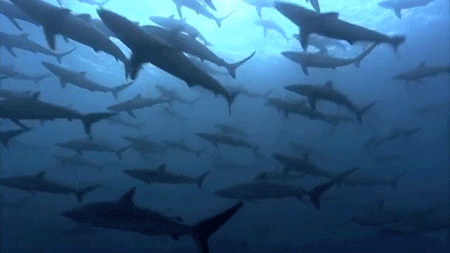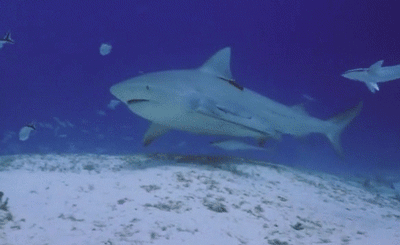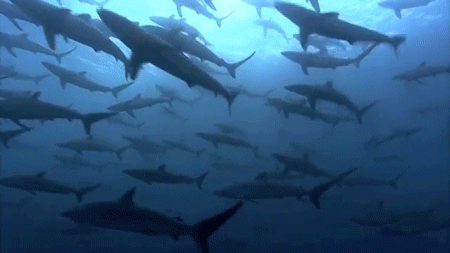Li-Fi Is 100 Times Faster Than Wi-Fi


Li-Fi is 100 times faster than Wi-Fi
What’s next in high-speed Internet? Beams of light, flickering faster than the eye can see. A recent test by New Delhi-based startup Velmenni used “Li-Fi” to transfer data at 1 gigabyte a second. The futuristic tech uses LED lightbulbs to send the high speed data — which could have a great impact on our world.
More Posts from Curiositytherover and Others

Tesla’s cheapest Model X is priced at $80,000

This Wristband Tells You Exactly What Vitamins You Need






This is Tech Tats, tattoos that can track your health data and your personal information - watch the full video

Humans might not be the only creatures that care about the welfare of other animals. Scientists are beginning to recognize a pattern in humpback whale behavior around the world, a seemingly intentional effort to rescue animals that are being hunted by killer whales.
Marine ecologist Robert Pitman observed a particularly dramatic example of this behavior back in 2009, while observing a pod of killer whales hunting a Weddell seal trapped on an ice floe off Antarctica. The orcas were able to successfully knock the seal off the ice, and just as they were closing in for the kill, a magnificent humpback whale suddenly rose up out of the water beneath the seal.
This was no mere accident. In order to better protect the seal, the whale placed it safely on its upturned belly to keep it out of the water. As the seal slipped down the whale’s side, the humpback appeared to use its flippers to carefully help the seal back aboard. Finally, when the coast was clear, the seal was able to safely swim off to another, more secure ice floe.
Read more
Read the study: Humpback whales interfering when mammal-eating killer whales attack other species: Mobbing behavior and interspecific altruism?

Artificial Intelligence, Boon or Bane? University of Cambridge Set to Find an Answer
Today’s science and technology are nearing a point where computers can recreate human-level intelligence. While it is difficult to say when exactly this will happen, some researchers are suggesting that this could take place sometime this century. In the press release, Stuart Russell, a world-leading AI researcher at the University of California, Berkeley, suggests that such a development would be “the biggest event in human history.”
Professor Stephen Hawking agrees, and adds that it remains to be seen whether or not artificial intelligence will be our greatest benefit or greatest downfall. He states, “when it eventually does occur, it’s likely to be either the best or worst thing ever to happen to humanity, so there’s huge value in getting it right.”
In anticipation of this, the University of Cambridge is to establish a new interdisciplinary research centre, the Leverhulme Centre for the Future of Intelligence, which will bring together computer scientists, philosophers, social scientists, and others to examine the technical, practical, and philosophical questions that artificial intelligence raises (or will raise) for humanity in the coming century.
It will be funded by a £10 million grant from the Leverhulme Trust.
Read more at: http://futurism.com/links/19069/





The plate is called a Chladni plate. When he plays it with a bow (you know, like a violin) the couscous aligns itself it certain patterns. We’re not sure if this is science or magic.



Why music might be killing sharks
For too long, sharks have been portrayed and perceived as the menacing, lurking creatures in the deep. Contrary to popular belief, we are much more of a threat to them than they are to us.
Researchers have found that the ominous music that often accompanies even documentary footage of them has inspired excessive fear about sharks.
In an experiment at UC San Diego, participants watched footage of sharks. Some scenes featured uplifting music, and others had a more daunting score.
The effect was what you might expect. Viewers saw sharks as intimidating creatures when they they also heard ominous music.
But with uplifting music (or none at all), viewers had a more positive impression of sharks.
This is problematic because rarely do we see shark footage without the ominous music, and the negative portrayals of sharks may be hindering conservation efforts.
“We know from prior research that conservation progress for sharks is sluggish compared to marine mammals and that this slow response may be due in part to the societal marginalization of sharks,” says study co-author Elizabeth Keenan.
After all, in the words of Senegalese conservationist Baba Diou, “we will conserve only what we love.”
And while they’re still not exactly a furry, cuddly rabbit, consider this: you’re more likely to be struck by lightening than fall prey to a fatal shark attack.


NASA is about to light the biggest human-made space fire ever
If a fire breaks out inside the cabin of a small spacecraft, there’s nowhere to run. But in order to figure out how large fires really behave in space, NASA is planning to light one on purpose. How they’re planning to conduct the test.
Follow @the-future-now
How Exactly Do We Plan to Bring an Asteroid Sample Back to Earth?
Our OSIRIS-REx spacecraft launches tomorrow, and will travel to a near-Earth asteroid, called Bennu. While there, it will collect a sample to bring back to Earth for study. But how exactly do we plan to get this spacecraft there and bring the sample back?

Here’s the plan:
After launch, OSIRIS-REx will orbit the sun for a year, then use Earth’s gravitational field to assist it on its way to Bennu. In August 2018, the spacecraft’s approach to Bennu will begin.

The spacecraft will begin a detailed survey of Bennu two months after slowing to encounter the asteroid. The process will last over a year, and will include mapping of potential sample sites. After the selection of the final site, the spacecraft will briefly touch the surface of Bennu to retrieve a sample.

To collect a sample, the sampling arm will make contact with the surface of Bennu for about five seconds, during which it will release a burst of nitrogen gas. The procedure will cause rocks and surface material to be stirred up and captured in the sampler head. The spacecraft has enough nitrogen to allow three sampling attempts, to collect between 60 and 2000 grams (2-70 ounces).

In March 2021, the window for departure from the asteroid will open, and OSIRIS-REx will begin its return journey to Earth, arriving two and a half years later in September 2023.

The sample return capsule will separate from the spacecraft and enter the Earth’s atmosphere. The capsule containing the sample will be collected at the Utah Test and Training Range.

For two years after the sample return, the science team will catalog the sample and conduct analysis. We will also preserve at least 75% of the sample for further research by scientists worldwide, including future generations of scientists.
The Spacecraft

The OSIRIS-REx spacecraft is outfitted with some amazing instruments that will help complete the mission. Here’s a quick rundown:
The OCAMS Instrument Suite

PolyCam (center), MapCam (left) and SamCam (right) make up the camera suite on the spacecraft. These instruments are responsible for most of the visible light images that will be taken by the spacecraft.
OSIRIS-REx Laser Altimeter (OLA)

This instrument will provide a 3-D map of asteroid Bennu’s shape, which will allow scientists to understand the context of the asteroid’s geography and the sample location.
OSIRIS-REx Thermal Emission Spectrometer (OTES)

The OTES instrument will conduct surveys to map mineral and chemical abundances and will take the asteroid Bennu’s temperature.
OSIRIS-REx Visible and Infrared Spectrometer (OVIRS)

This instrument will measure visible and near infrared light from the asteroid. These observations could be used to identify water and organic materials.
Regolith X-Ray Imaging Spectrometer (REXIS)

REXIS can image X-ray emission from Bennu in order to provide an elemental abundance map of the asteroid’s surface.
Touch-and-Go Sample Arm Mechanism (TAGSAM)

This part of the spacecraft will be responsible for collecting a sample from Bennu’s surface.
Watch Launch and More!

OSIRIS-REx Talk Wednesday, Sept. 7 at noon EDT Join us for a discussion with representatives from the mission’s science and engineering teams. This talk will include an overview of the spacecraft and the science behind the mission. Social media followers can ask questions during this event by using #askNASA. Watch HERE.
Uncovering the Secrets of Asteroids Wednesday, Sept. 7 at 1 p.m. EDT During this panel, our scientists will discuss asteroids, how they relate to the origins of our solar system and the search for life beyond Earth. Social media followers can ask questions during this event by using #askNASA. Watch HERE.
LAUNCH COVERAGE!
Thursday, Sept. 8 starting at 4:30 p.m. EDT
Watch the liftoff of the United Launch Alliance’s (ULA) Atlas V rocket from Kennedy Space Center in Florida at 7:05 p.m.
Full coverage is available online starting at 4:30 p.m. Watch
HERE
.
We will also stream the liftoff on Facebook Live starting at 6:45 p.m. EDT. Watch
HERE
.
Make sure to follow us on Tumblr for your regular dose of space: http://nasa.tumblr.com

Gearing up for Thanksgiving weekend and desperate for small talk topics that make you sound slightly smarter? We’ve got you covered:
1. Tricks for building a Wi-Fi network that covers your entire house Excellent Wi-Fi coverage in your home may be easier to achieve than you might think—if you’ve got the right router placed in a central position, a Wi-Fi extender if needed, and a little bit of patience. via: BGR
2. The dream life of driverless cars Thanks to 3D scanning, driverless cars can do more than take you from one place to another: They can also produce artistic renditions of their surrounding environments, peculiarities and all. Talk about an IoT dream journal. via: The New York Times
3. Lego’s new digital system and other “toys-to-life” will be huge this holiday season Toys won’t only be played within the realm of a child’s imagination, but in mobile apps that can take physical toys into virtual spaces. via: @quartz
4. The dictionary, emoji, and redefining the word ‘word’ What do rent money, fart jokes, and student loans have in common? They all solicit a reaction that’s encapsulated in Oxford Dictionaries’ Word of the Year: the Face with Tears of Joy emoji. via: @theverge
-
 vivant-amour-rire reblogged this · 7 years ago
vivant-amour-rire reblogged this · 7 years ago -
 metakacke liked this · 8 years ago
metakacke liked this · 8 years ago -
 sirwoodwerd reblogged this · 8 years ago
sirwoodwerd reblogged this · 8 years ago -
 onigori reblogged this · 9 years ago
onigori reblogged this · 9 years ago -
 crippledcow liked this · 9 years ago
crippledcow liked this · 9 years ago -
 claire-mckay reblogged this · 9 years ago
claire-mckay reblogged this · 9 years ago -
 claire-mckay liked this · 9 years ago
claire-mckay liked this · 9 years ago -
 9r7g5h liked this · 9 years ago
9r7g5h liked this · 9 years ago -
 myfandomforahorse liked this · 9 years ago
myfandomforahorse liked this · 9 years ago -
 standingonthesky liked this · 9 years ago
standingonthesky liked this · 9 years ago -
 angels-fall-cause-i-push-them liked this · 9 years ago
angels-fall-cause-i-push-them liked this · 9 years ago -
 yumekor liked this · 9 years ago
yumekor liked this · 9 years ago -
 doilooklikeiknoworcare liked this · 9 years ago
doilooklikeiknoworcare liked this · 9 years ago -
 interestedpasserby reblogged this · 9 years ago
interestedpasserby reblogged this · 9 years ago -
 interestedpasserby liked this · 9 years ago
interestedpasserby liked this · 9 years ago -
 swagfable liked this · 9 years ago
swagfable liked this · 9 years ago -
 dangerouswolfpuppy liked this · 9 years ago
dangerouswolfpuppy liked this · 9 years ago -
 tinyturtletimtim liked this · 9 years ago
tinyturtletimtim liked this · 9 years ago -
 truthislow liked this · 9 years ago
truthislow liked this · 9 years ago -
 mrdaxxonford liked this · 9 years ago
mrdaxxonford liked this · 9 years ago -
 rosymochiii reblogged this · 9 years ago
rosymochiii reblogged this · 9 years ago -
 rosymochiii liked this · 9 years ago
rosymochiii liked this · 9 years ago -
 kichonarose reblogged this · 9 years ago
kichonarose reblogged this · 9 years ago -
 kichonarose liked this · 9 years ago
kichonarose liked this · 9 years ago -
 bleeding-empress liked this · 9 years ago
bleeding-empress liked this · 9 years ago -
 sciencefictioness reblogged this · 9 years ago
sciencefictioness reblogged this · 9 years ago -
 niaofnarnia reblogged this · 9 years ago
niaofnarnia reblogged this · 9 years ago -
 officallyahuman reblogged this · 9 years ago
officallyahuman reblogged this · 9 years ago -
 officallyahuman liked this · 9 years ago
officallyahuman liked this · 9 years ago -
 saltlampblues liked this · 9 years ago
saltlampblues liked this · 9 years ago -
 pieces-of-silverwing reblogged this · 9 years ago
pieces-of-silverwing reblogged this · 9 years ago -
 pieces-of-silverwing liked this · 9 years ago
pieces-of-silverwing liked this · 9 years ago -
 theamazingmugi reblogged this · 9 years ago
theamazingmugi reblogged this · 9 years ago -
 theamazingmugi liked this · 9 years ago
theamazingmugi liked this · 9 years ago -
 niaofnarnia liked this · 9 years ago
niaofnarnia liked this · 9 years ago -
 talos1guestservices liked this · 9 years ago
talos1guestservices liked this · 9 years ago -
 magicosaurus reblogged this · 9 years ago
magicosaurus reblogged this · 9 years ago -
 dancing-in-the-rain-gf liked this · 9 years ago
dancing-in-the-rain-gf liked this · 9 years ago -
 magicosaurus liked this · 9 years ago
magicosaurus liked this · 9 years ago -
 glitch-bite liked this · 9 years ago
glitch-bite liked this · 9 years ago -
 glitch-bite reblogged this · 9 years ago
glitch-bite reblogged this · 9 years ago